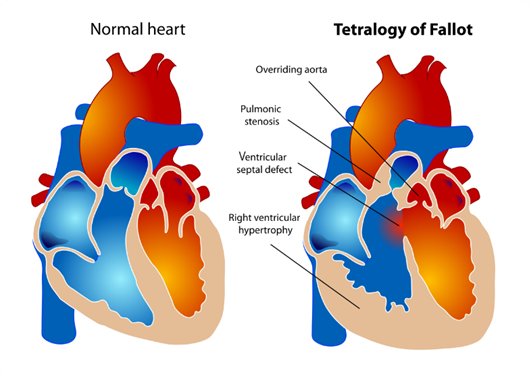A nurse is caring for an infant who has Tetralogy of Fallot and notes that the infant is easily fatigued when eating. Which defect is not present in this cardiac congenital malformation?
Overriding aorta
Pulmonary stenosis
Left ventricular hypertrophy
Ventricular septal defect
The Correct Answer is C
A. Overriding aorta: In Tetralogy of Fallot, the aorta is positioned over the ventricular septal defect (VSD), rather than solely over the left ventricle as it would be in a normal heart. This is called overriding aorta, which allows blood from both the right and left ventricles to enter the aorta.
B. Pulmonary stenosis: This is a critical component of Tetralogy of Fallot. Pulmonary stenosis refers to narrowing of the pulmonary valve or the area just below it, which restricts blood flow from the right ventricle to the pulmonary artery. This results in decreased blood flow to the lungs for oxygenation.
C. Left ventricular hypertrophy: This choice is not typically associated with Tetralogy of Fallot. Left ventricular hypertrophy refers to an enlargement or thickening of the muscular wall of the left ventricle of the heart. It is often seen in conditions where the left ventricle has to work harder to pump blood, such as in hypertension or aortic stenosis, but it is not a characteristic feature of Tetralogy of Fallot.
D. Ventricular septal defect: This defect is one of the four components of Tetralogy of Fallot. A ventricular septal defect (VSD) is a hole in the septum, the muscular wall that separates the left and right ventricles of the heart. In Tetralogy of Fallot, the VSD allows oxygen-poor blood from the right ventricle to flow directly into the left ventricle and out to the body.

Nursing Test Bank
Naxlex Comprehensive Predictor Exams
Related Questions
Correct Answer is D
Explanation
A. Allow the child to see and touch IV tubing and supplies.
Allowing the child to see and touch the IV tubing and supplies can help familiarize them with the equipment and reduce anxiety. However, there may be a more appropriate action to take first.
B. Explain to the child's parents what role they will have during the procedure.
While it's important to involve the child's parents and inform them of their role during the procedure, the priority should be to prepare the child for the insertion itself.
C. Describe the procedure using visual aids.
Using visual aids can be helpful in explaining the procedure to the child and providing a clear understanding of what will happen. However, there may be a more appropriate action to take first.
D. Ask the child what he knows about the procedure.
This is the correct answer. Asking the child what they already know about the procedure allows the nurse to assess their understanding and address any misconceptions or concerns they may have. It also helps the nurse tailor their explanation to the child's level of understanding and provide information that is relevant and meaningful to them.
Correct Answer is A
Explanation
A. Give the child a stuffed animal: Providing a comforting item like a stuffed animal can help the child feel more secure and may offer some comfort during the parent's absence. This option is appropriate as it addresses the child's emotional needs.
B. Inform the child that her parent will be back in 2 hours: While it's helpful to provide reassurance to the child, a 2-year-old may not fully understand the concept of time, and telling them that their parent will return in 2 hours may not effectively alleviate their distress. This option may not be as immediately comforting as providing a tangible source of comfort.
C. Call the parent to return to the child's room: If possible, having the parent return to the child's room can provide the most direct comfort and reassurance to the child during a tantrum. However, it may not always be feasible for the parent to return immediately, especially if they are occupied or attending to other responsibilities.
D. Leave the child alone in the room for 5 minutes: Leaving the child alone during a tantrum can exacerbate feelings of distress and abandonment, potentially escalating the situation further. It's essential to provide support and reassurance to the child during moments of distress rather than leaving them alone.
Whether you are a student looking to ace your exams or a practicing nurse seeking to enhance your expertise , our nursing education contents will empower you with the confidence and competence to make a difference in the lives of patients and become a respected leader in the healthcare field.
Visit Naxlex, invest in your future and unlock endless possibilities with our unparalleled nursing education contents today
Report Wrong Answer on the Current Question
Do you disagree with the answer? If yes, what is your expected answer? Explain.
Kindly be descriptive with the issue you are facing.
